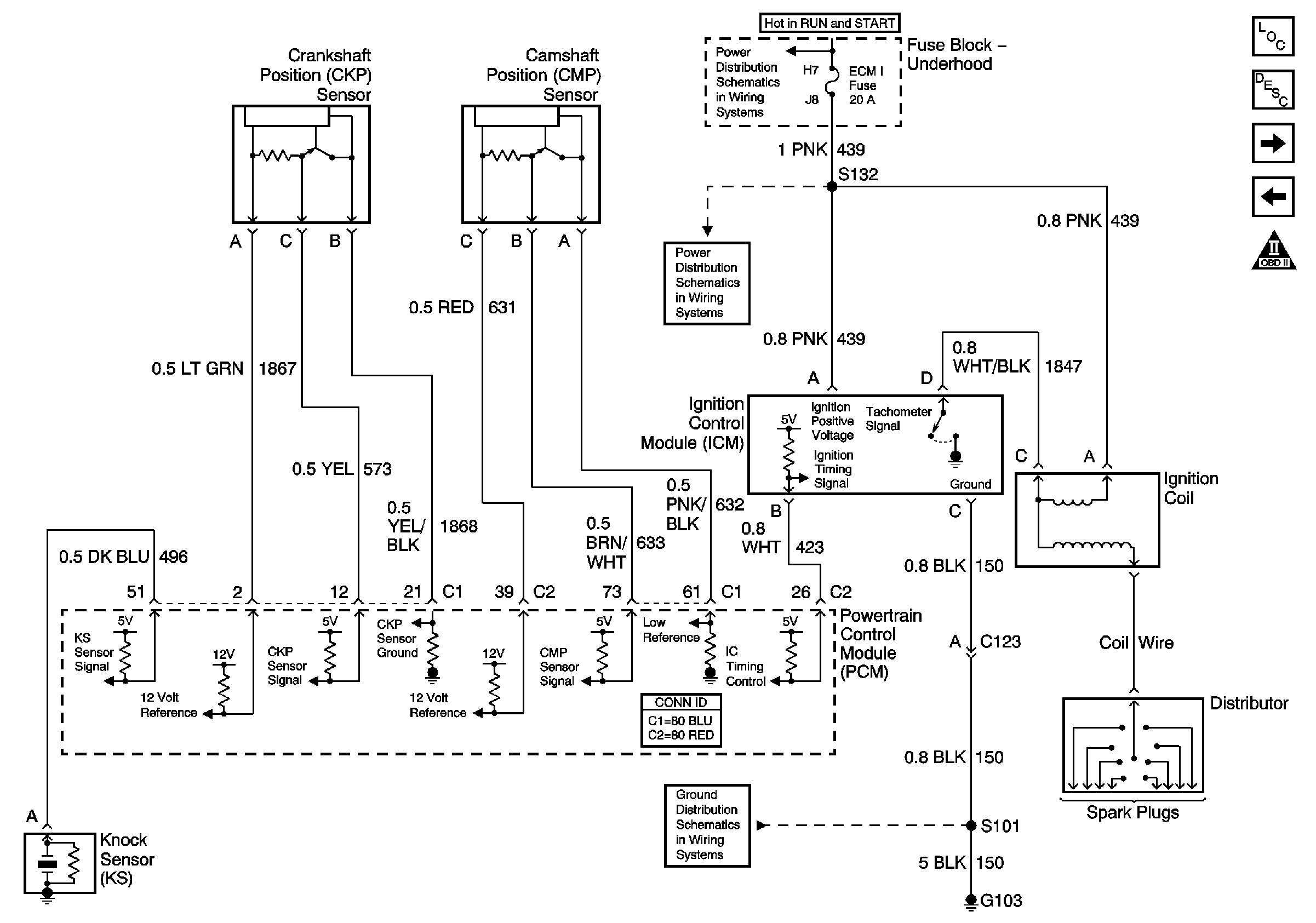Circuit Description
The knock sensor produces an AC voltage at all engine speeds and loads. The powertrain control module (PCM) then adjusts the spark timing based on the amplitude and frequency of the KS signal. The PCM uses the KS signal to calculate the average voltage. Then the PCM assigns a voltage value. The PCM checks the knock sensor and related wiring by comparing the actual knock signal to the assigned voltage range. A normal KS signal should stay outside the assigned voltage range. This DTC will set if the KS signal is within the assigned voltage range or not present.
Conditions for Running the DTC
| • | DTCs P0117, P0118, P0121, P0122, P0123, P0125, P1114, P1115, P1121, P1122 are not set. |
| • | Engine run time is more than 10 seconds. |
| • | The engine coolant temperature (ECT) is more than 60°C (131°F). |
| • | Engine speed is between 2000 RPM and 3000 RPM. |
| • | The manifold absolute pressure (MAP) is more than 45 kPa. |
Conditions for Setting the DTC
The PCM detects a knock sensor voltage within the calculated average voltage range or not present.
Action Taken When the DTC Sets
| • | The control module illuminates the malfunction indicator lamp (MIL) on the second consecutive ignition cycle that the diagnostic runs and fails. |
| • | The control module records the operating conditions at the time the diagnostic fails. The first time the diagnostic fails, the control module stores this information in the Failure Records. If the diagnostic reports a failure on the second consecutive ignition cycle, the control module records the operating conditions at the time of the failure. The control module writes the operating conditions to the Freeze Frame and updates the Failure Records. |
Conditions for Clearing the MIL/DTC
| • | The control module turns OFF the malfunction indicator lamp (MIL) after 3 consecutive ignition cycles that the diagnostic runs and does not fail. |
| • | A current DTC, Last Test Failed, clears when the diagnostic runs and passes. |
| • | A history DTC clears after 40 consecutive warm-up cycles, if no failures are reported by this or any other emission related diagnostic. |
| • | Clear the MIL and the DTC with a scan tool. |
Diagnostic Aids
Check the knock sensor for proper installation. A knock sensor that is loose or over torqued may cause the DTC to set.
For an intermittent condition, refer to Intermittent Conditions .
Check and correct any abnormal engine noise before using the diagnostic table.
Step | Action | Values | Yes | No | ||||||
|---|---|---|---|---|---|---|---|---|---|---|
Schematic Reference:
| ||||||||||
1 | Did you perform the Diagnostic System Check-Engine Controls? | -- | Go to Step 2 | Go to | ||||||
2 |
Important: If an engine knock can be heard, repair the engine mechanical condition before proceeding with this diagnostic.
Does the scan tool indicate that this diagnostic failed this ignition? | -- | Go to Step 3 | Go to Diagnostic Aids | ||||||
3 |
Is the resistance of the knock sensor near the specified range? | 100 K | Go to Step 4 | Go to Step 6 | ||||||
4 |
Important: Do not tap on plastic engine components. Is any signal indicated on the DMM while tapping on the engine block near the knock sensor? | -- | Go to Step 5 | Go to Step 6 | ||||||
5 |
Refer to Testing for Continuity , Testing for a Short to Voltage , and Testing for Short to Ground in Wiring Systems. Did you find and correct the condition? | -- | Go to Step 9 | Go to Step 7 | ||||||
6 | Replace the knock sensor. Refer to Knock Sensor Replacement . Did you complete the replacement? | -- | Go to Step 9 | -- | ||||||
7 |
Did you find and correct the condition? | -- | Go to Step 9 | Go to Step 8 | ||||||
8 | Replace the PCM. Refer to Powertrain Control Module Replacement . Did you complete the replacement? | -- | Go to Step 9 | -- | ||||||
9 |
Does the scan tool indicate that this test ran and passed? | -- | Go to Step 10 | Go to Step 2 | ||||||
10 | Select the Capture Info option and Review Info option using the scan tool. Does the scan tool display any DTCs that you have not diagnosed? | -- | System OK | |||||||

